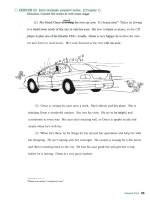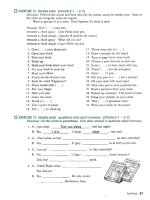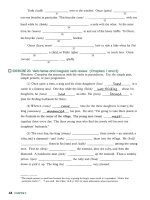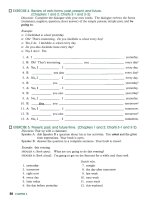Fundamentals of english grammar third edition part 4 pot
Bạn đang xem bản rút gọn của tài liệu. Xem và tải ngay bản đầy đủ của tài liệu tại đây (386.08 KB, 7 trang )
SUBJECT
+
FREQADV
:a) Karen
always
seldom
mrely
hardly ever
almost never
not ever,
neve*
1-3
FREQUENCY ADVERBS
VERB
tells
the truth.
:c) Do
you
alwrrys
eat breakfast?
:d)
Ann
usually doesn't eat
breakfast.
:e) Sue
dossn't
ahwys
eat breakfast.
:f)
CORRECT:
Anna
never eats
meat.
:g)
INCORRECT:
Anna doesn't nw eat meat.
:h)
-
Do you
ovsr
take the bus to work?
-Yes, I do. I often take the bus.
:i)
I
don't
ewer
walk to work.
:j) INCORRECT:
I
ever
walk
to work.
Frequency adverbs usually occur
in
the middle
of a sentence and have s~ec~al oositions. as
shown in examples (a) &ougG (e) below.
The adverbs with the symbol
''y
may also occu
at the beginning or end of a sentence.
I
sometimes
get
up
at 6:30.
Sometimss
I
get
up
at 6:30.
I
get
up
at 6:30
sometimes.
The other adverbs in the list (the ones not
marked by
"t")
rarely occur at the beginning or
end of a sentence. Their usual position is
in
the
middle of a sentence.
Frequency adverbs usually come between the
subject and the simple present verb (except
main verb be).
Frequency adverbs follow be in the simple
present (am,
is,
are) and simple past (was, were).
In a question, frequency adverbs come directly
after the subject.
In a negative sentence, most frequency adverbs
come
in
front of a negative verb (except always
and ever).
Ahwys
follows a negative helping verb or
negative be.
Negative adverbs (sekiom, rarely, hardy ever,
never) are NOT used with a negative verb.
Ever
is used
in
questions about frequency, as in
(h). It means "at any time."
Eusr
is also used
with
not,
as
in
(i).
Ever
is
NOT
used in statements.
EXERCISE
9.
The meaning
of
frequency adverbs. (Chart
1-3)
Directions: Answer the questions. Discuss the meaning of
the
frequency adverbs.
What
is
something
that.
. .
1.
you
seldom
do?
2.
you often do before you go to bed?
3.
a
polite person often does?
4.
a
polite person never does?
5.
I
frequently
do
in
class?
6.
I
usually don't
do
in
class?
7.
you rarely eat?
8.
you occasionally
do
after class?
9.
drivers generally do?
10.
people
in
your country always
or
usually
do
to celebrate the NewYear?
Present Tlme
9
EXERCISE 10. Position of frequency adverbs. (Chart 1-3)
?
:
Direcdons:
Add the
word
in
italics
to the sentence. Put the word in its usual midsentence
position.
dwyr
1.
always
Tom
A
studies at home in the evening.
2.
always
Tom is at home in the evening.
3.
usually
The mail comes at noon.
4.
unrallj
The mail is here by noon.
5.
generally
I
eat lunch around one o'clock.
6.
genemlly
Tom
is
in
the lunch room around one o'clock.
7.
genemlly
What time do you eat lunch?
8.
usually
Are you in bed by midnight?
EXERCISE
11.
Frequency adverbs in negatlve sentences. (Chart 1-3)
Direcdons:
Add the given words to the sentence. Put the adverbs in their usual
midsentence position. Make any necessary changes in the sentence.
1.
Sentence:
Jack doesn't shave
in
the morning.
a. usually
Jack usually doesn't shave in the morning.
b. often
-t
Jauk
ojien doesn't shave in
the
morning.
'
c frequently
f.
always i. hardly ever
d. occasionally
g. ever
j.
rarely
i
e. sometimes
h. never k. seldom
2.
I
don't eat breakfast.
a. usually b. always c. seldom d. ever
3.
My roommate isn't home in the evening.
a. generally b. sometimes c. always d. hardly ever
EXERCISE
12.
Using the slmple present with frequency adverbs. (Charts
1-1
+
1-3)
Directions:
Work
in
pairs. Use frequency adverbs to talk about yourself.
Speaker
A:
Your book is open. Tell your classmate about yourself, using the given ideas
and frequency adverbs.
Speaker
B:
Your book is closed. Repeat the information Speaker
A
just gave you.
Speaker
A:
If
Speaker
B
did not understand correctly, repeat the information.
If
Speaker
B
understood the information say, "Right. How about you?"
Speaker
B:
Answer the question, using a frequency advefb.
Example:
walk to school
~PBAKER
A
(book open):
I
usually walk to school.
SPEAKER
B
&ok closed):
You usually walk to school.
SPEAKER
A
&ok
open):
Right. How about you? Do you ever walk to school?
SPEAKER
B
(book
closed):
I
seldom walk to school.
I
usually take the bus.
OR
I
usually
walk to school too.
10
CHAPTER
1
1.
wear a suit to class
w',?iw
2.
go
to sleep before eleven-thirty
.
~:&:
3.
get at least one e-mail a day
4. read in bed before
I
go to sleep
5.
listen to the radio in the morning
6.
speak to people who sit next to me on an airplane
Switch roles.
7.
wear jeans to class
8.
read poetry in my spare time
9.
believe the things
I
read
in
newspapers
10.
get up before nine o'clock in the morning
11.
call my family or a friend
if
I
feel homesick or lonely
12.
have chocolate ice cream for dessert
EXERCISE 13. Activity: topics for discussion or writing. (Charts 1-1
+
1-3)
Directions: Discuss the topics in pairs,
in
groups, or as a class. Topics can also be used for
writing practice. Use several frequency adverbs with each topic. See Chart 1-3 for a list of
frequency adverbs.
Exumple:
What are some of the things you do when you get up in the morning?
+
I
generally turn on the news.
I
alevays brush
my
teeth.
I
seldom make my bed.
I
usually
rake
a shower.
I
never take
a
bath.
PART
I.
What are some
thii
you do
.
.
.
1.
when you get ready to go to bed at night?
2.
when you travel abroad?
3.
in this classroom?
4.
when you're on vacation?
5.
when your airplane flight is delayed?
6.
when you use a computer?
PART
XI.
What are some things people in your country do
7.
at the diier table?
8.
to celebrate their birthdays?
9.
when a chid misbehaves?
10.
when they meet someone for the first time?
11.
when they want to have
fun?
12.
at a wedding?
(a)
SINGUULR:
one
bird
-
-
-
~
~
@)
PLURAL:
KUO
birak,
three
birak,
mavy
birds,
aU
birds,
etc.
(c)
Birds
sing.
(d)
A
bird
sings.
(e)
A
bird
sings
outside my window.
It
rings
loudly.
Ann
sings
beautifully.
She
sings
songs
to
her
children.
Tom
sings
very well.
He
sings
in
a
chorus.
SINGULAR
=
one, not two or more
?LURAL
=
two,
three, or more
A
plural
noun
ends in
-8,
as
in
(-,
.
A
singular
verb
ends in
-s,
as in (d).
A
singular verb follows a singular subject.
Add
-s
to the simple present verb
if
the subject
is
(1)
a
singular noun (e.g.,
a
bird,
Ann,
Tom)
or
(2)
he,
she, or
it.*
*He,
she,
and
ir
are
third
person singular personal pmnouns. See
Chart
6-10,
p.
171,
for
more information about personal
pronouns.
EXERCISE 14. Using final
4.
(Chart 1-4)
Directions:
Look at each word that ends in
-s.
Is it
a
noun or a verb? Is it singular or
plural?
1. Ali lives in an apartment.
+
'7iieres"
=
a
singular
verb
2.
Plants grow.
-*
"plants"
=
a
plural
noun
3.
Ann
listens to the radio
in
the morning.
4.
The students at this school work hard.
5.
A doctor helps sick people.
6.
Planets revolve around the
sun.
7.
A dictionary lists words in alphabetical order.
8.
MI.
Lee likes to go to Forest Park
in
the spring. He takes the bus. He sits on a bench
near a pond and feeds the birds. Ducks
swim
toward him for food, and pigeons land
all around him.
EXERCISE 15. Preview: spelling
of
final 41-ES. (Chart 1-5)
Directions:
Add final
-51-es.
3.
hope-
4.
reach-
5.
move-
6.
kiss-
7.
push-
8.
wait-
9.
mix-
10. blow-
11. study-
12.
buy-
13.
enjoy-
14. fly-
15.
carry-
12
CHAPTER
1
I
1-5
SPELLING
OF
FINAL
-SI-ES
.
.
. . . .
.
.~.
.
.
~.
I
speak
+
speaks
@)
ride
+
rides
write
-t
writes
(c) catch
+
catches
wash
-'
washes
miss
+
misses
fix
+fies
buzz
-'
bueass
(f)
go
+
goes
IgowZ,
do
+
does
/dad
have
+
has
hed
rulal
4,
UUL
-as,
ir
wusu
ru
uaurr
vstv~.
INCORRECT:
oisites, speakes
Many verbs end in
-s.
Final
-s
is simply added.
Final
-us
is added to words that end in
-ch, -sh, -s,
y
and
-z.
PRONUNCIATION
NOTE:
Final
-ap
is pronounced /ad and adds a
syllable.*
If a word ends in a consonant
+
-y,
change the
y
to
-i
and add
-es.
(INCORRECT:
flyS)
If
a word ends in a vowel
+
-y,
simply add
-s.**
(INCORRECT:
Daier
or
Dayes)
The singular forms of the verbs
go,
do,
and
have
are irregular.
L
*See Chart
6-1
for
more
informtion about the pronunciation of final
4-es
**Vowels
=
a,
e, i, o,
u.
Consonmts
=
all
other
letten
in the alphabet.
EXERCISE
16.
Simple present verbs: using
final
41-ES. (Charts
1-4
and
1-5)
Directions:
Underline the verb in each sentence. Add final
-81-os
to the verb
if
necessary.
Do not change any other words.
1.
A
dog
M.
+
bavks
I
2.
Dogs
m.
+
OK
(no
change)
3.
Wood float on
water.
4.
Rivers flow toward the sea.
5.
My mother worry about me.
6.
A student
buy
a lot of books at the beginning of each term.
7.
Airplanes fly all around the world.
8.
Mr.
Wong teach Chinese
at
the university.
9.
The teacher
ask
us
a
lot of questions
in
class every day.
10.
Mr.
Cook watch game shows onTV every evening.
i\
'+&b.;
2
11.
Music consist of pleasant sounds.
-?,,
,
~,
,,
.
;LA
ni
'
g.::.,
,
/.,;
ST.
.,
.
,
.
,
-2
.
,
.*
3
12. Cats usually sleep eighteen hours a day.
13. The front page of a newspaper contain the most important news of the day.
14. Water freeze at 32OF (O•‹C) and boil at 212•‹F (lOO•‹C).
15.
Mrs.
Taylor never cross the street in the middle of a block. She always walk to the
corner and use the pedestrian walkway.
16. Many parts of the world enjoy four seasons: spring, summer, autumn, and winter.
Each season last three months and bring changes in the weather.
EXERCISE
17.
Simple present verbs: using final
41-ES.
(Charts
1-4
and
1-5)
Directionc
Count aloud around the class to the number 24. Find your number(s)
in
the
exercise list, and write the words that appear beside
it
on a slip of paper. Then close your
book.
Walk around the classroom and read your words aloud to classmates. You are looking
for the other half of your sentence.
When you find the person with the other half, combine the information on your two
slips of paper into a sentence. Write the sentence on the chalkboard or on a piece of
paper. Make changes in the verb
if
necessary.
Exatnple
(using
item
1
and
8):
A
star shines in the sky at night.
1. astar
2. causes air pollution
3.
stretch when you pull on it
4.
a hotel
5. newspaper ink
6.
supports
a
huge variety of marine life
7. a bee
8. shine
in
the sky at night
9. cause great destruction when it reaches
land
10. a river
11.
improves your circulation and general
health
12. an elephant
13. a hurricane
14. produce one-fourth of the world's
coffee
15. oceans
16. use in long trunk like a hand to pick
things up
17. Brazil
18. supply its guests with clean towels
19. a rubber band
20. gather nectar from flowers
21. flow downhiill
22. stain my hands when
I
read the paper
23. automobiles
24. does physical exercise
EXERCISE
18.
The simple present and the present Droaressive. Charts
1-1
-
1-5)
.
-
Directions:
Create
three
sentences about d;e activity shown
in
eachbicture. Work
in
pks,
in groups, or as a class.
Senrmce
1:
Activity
in
progress:
Describe what the person
in
the picture is doing.
Sentence
2:
Usual
eequency:
Describe how often this person probably does this activity.
Sentence
3:
Generalization:
Make
a
general statement or two about this activity.
,.:
.,
.
Example:
Sentence
1:
The
man
in
the picture
is
swimming.
Senfpce
2:
It looks like he's near a tropical island.
If
he's on vacation there, he probably
g
.
swims
every day.
If
he lives there all the time, he probably
swims
once or twice
;
2
a week.
Sentence
3:
People
m'm
for enjoyment and exercise. Swimming
in
the ocean
is
fun.
Present
nme
15









